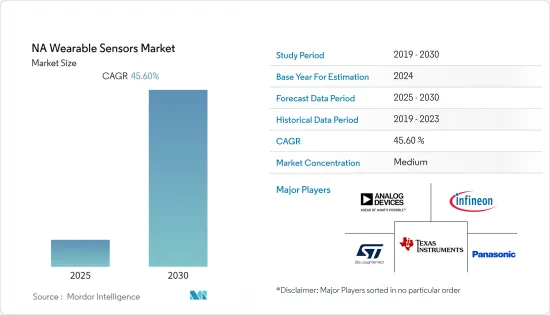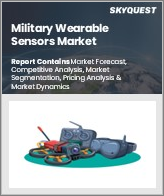
|
시장보고서
상품코드
1627128
북미의 웨어러블 센서 : 시장 점유율 분석, 산업 동향 및 통계, 성장 예측(2025-2030년)NA Wearable Sensors - Market Share Analysis, Industry Trends & Statistics, Growth Forecasts (2025 - 2030) |
||||||
■ 보고서에 따라 최신 정보로 업데이트하여 보내드립니다. 배송일정은 문의해 주시기 바랍니다.
북미의 웨어러블 센서 시장은 예측 기간 동안 45.6%의 CAGR을 기록할 것으로 예상됩니다.

주요 하이라이트
- 웨어러블 센서가 중요한 역할을 하는 건강 및 피트니스에 대한 인식이 높아짐에 따라 시장이 성장하고 있습니다. 또한, 연구 개발에 대한 투자로 인해 웨어러블 센서 제조에 사용되는 부품의 가격이 하락하여 웨어러블 기기의 가격이 저렴해졌습니다.
- 피트니스, 헬스케어, 보안을 위한 웨어러블 기술 등 다양한 응용 분야에 대한 수요 증가는 북미의 웨어러블 센서 시장의 급격한 성장을 이끄는 원동력입니다.
- COVID-19가 유행하면서 현장 의료진에게 실시간 데이터를 제공하고 체온이 높은 사람을 신속하게 선별할 수 있는 웨어러블 기기 센서에 대한 수요가 급증했습니다.
- 그러나 현재 진행 중인 칩 부족으로 인해 칩의 가용성은 감소할 것으로 예상됩니다. 구매 가능한 제품이 줄어들고 수요가 증가함에 따라 웨어러블 센서와 웨어러블 센서 기반 기기의 가격이 상승할 것으로 예상됩니다.
북미의 웨어러블 센서 시장 동향
웨어러블 피트니스 기기 수요 증가로 시장 견인
- 이 지역의 웨어러블 센서의 주요 시장 중 하나는 스포츠 피트니스 시장으로, Nike Fuelband, Jawbone UP, Microsoft Band, Fitbit 등 피트니스 트래킹을 위한 제품이 시장에 출시되고 있습니다.
- 이러한 장치는 몸에 착용하여 걸음 수, 이동 거리, 칼로리 소모량 등 다양한 매개 변수를 추적하고 휴대 전화와 동기화하여 매일의 진행 상황을 추적 할 수 있습니다. 이 지역에서 이러한 장치가 널리 보급되는 이유는 사람들의 과체중과 비만이 심각한 문제로 대두되고 있기 때문입니다.
- CDC에 따르면 미국 성인의 65.5%, 어린이의 약 17%가 비만입니다. 이 문제는 불규칙하고 건강에 해로운 식습관과 운동 부족으로 인해 확대되고 있습니다.
- 웨어러블 단말기는 대중의 건강 증진에 도움이 되고 있습니다. 스포츠 및 피트니스 분야에서 웨어러블 기기의 응용은 북미에서 거대한 시장이 되고 있습니다. 많은 기기 제조업체들이 피트니스 트래킹 솔루션의 매출 증가를 목격하고 있습니다.
웨어러블 기술에 대한 소비자 관점의 변화
- 웨어러블 기기에 대한 소비자의 관점은 지난 10년간 소비자 및 환경과의 관계를 변화시키는 기능과 진화하는 기술 통합으로 인해 변화하고 있으며, 그 인기는 점점 높아지고 있습니다.
- 피트니스 트래커, 스마트워치 등 웨어러블 기기 중 가장 큰 영향을 미치는 요인은 연령, 소득, 성별입니다. AARP 2020 보고서에 따르면, 미국 50세 이상, 50-59세, 60-69세, 70세 이상 성인의 웨어러블 기술 사용 연령은 각각 83%, 87%, 81%, 79%로 나타났습니다.
- 또한 Attest의 소비자 조사 및 세대별 트렌드 보고서 2019에 따르면 2019년 영국에서 스마트워치/헬스 트래커 컴퓨팅 기기를 소유한 응답자의 비율은 32.1%로, Z세대가 32.7%, 밀레니얼 세대가 37.6%, X세대가 31.4%, 베이비붐 세대가 22.2%였습니다.
- 또한, 이러한 웨어러블 기기에 대한 소비자의 관점은 기술 채택이 증가함에 따라 그들의 기대에 부응하는 방향으로 변화하고 있습니다. 기능적 개선이 요구되고 있음에도 불구하고 웨어러블 사용에 관심을 갖는 소비자들이 증가하고 있습니다. 이에 따라 제조업체들은 웨어러블 제품을 다양화하고 소비자들이 강조하는 문제를 극복할 수 있는 기회를 창출하고 있습니다.
- 또한, IoT의 성장과 함께 소비자들은 웨어러블을 사용하여 다른 기기 및 주변 물리적 사물과 정보를 교환할 것으로 예상하고 있습니다.
북미의 웨어러블 센서 산업 개요
북미의 웨어러블 센서 시장은 현지 기업과 소수의 국제 기업이 혼합된 소수의 국제 기업에 의해 지배되고 있으며, 적당히 단편화되어 있습니다.
- 웨어러블 스마트밴드 제조업체의 주요 업체는 Apple Inc., Huawei Technologies, Polar Electro Oy, Garmin Ltd. Electronics로 구성되어 있습니다. 이들은 시장 지위와 점유율을 유지하기 위해 최신 기술을 통합하여 제품을 지속적으로 업데이트하고 있습니다.
- 2020년 3월 : 시장의 일부 공급업체들은 의료 기관과 제휴하여 다양한 건강 관련 질병 및 문제를 감지하고 자사 브랜드 스마트워치에 경쟁 우위를 제공하기 위해 기기 내에 내장할 수 있는 다양한 센서를 조사하고 있습니다. 예를 들어, Fitbit은 Scripps Research Institute 및 Stanford Medicine과 협력하여 Fitbit의 데이터를 활용하여 COVID-19와 같은 감염병을 감지, 추적 및 격리하는 데 도움이 되는 연구를 진행하고 있습니다.
기타 혜택:
- 엑셀 형식의 시장 예측(ME) 시트
- 3개월간의 애널리스트 지원
목차
제1장 소개
- 조사 가정과 시장 정의
- 조사 범위
제2장 조사 방법
제3장 주요 요약
제4장 시장 역학
- 시장 개요
- 업계의 매력 - Porter's Five Forces 분석
- 신규 참여업체의 위협
- 구매자/소비자의 협상력
- 공급 기업의 교섭력
- 대체품의 위협
- 경쟁 기업 간의 경쟁 관계
- 시장 성장 촉진요인
- 센서의 급속한 기술 개발과 소형화
- 산업 분야에서의 애플리케이션 증가
- 시장 성장 억제요인
- 산업 분야에의 대규모 도입을 위한 높은 초기 비용
- 산업 밸류체인 분석
- COVID-19의 시장에 대한 영향
- 기술 현황
- 주요 기술 개요(MEMS, CMOS 등)
제5장 시장 세분화
- 유형별
- 헬스 센서
- 환경 센서
- MEMS 센서
- 모션 센서
- 기타
- 디바이스별
- 리스트웨어
- 바디웨어 & 신발
- 기타
- 용도별
- 헬스 및 웰니스
- 보안 모니터링
- 홈 재활
- 기타
- 국가별
- 미국
- 캐나다
제6장 경쟁 구도
- 기업 개요
- STMicroelectronics
- Infineon Technologies AG
- Texas Instruments Incorporated
- Analog Devices Inc.
- InvenSense Inc.
- Freescale Semiconductor Inc
- Panasonic Corporation
- NXP Semiconductors N.V.
- TE Connectivity Ltd.
- Bosch Sensortec GmbH(Robert Bosch GmbH)
제7장 투자 분석
제8장 시장 기회와 향후 동향
ksm 25.01.17The NA Wearable Sensors Market is expected to register a CAGR of 45.6% during the forecast period.

Key Highlights
- The market is driven by the rising awareness of health and fitness, where wearable sensors play a vital role. Moreover, due to investments in research and development, the reducing price of the components used to manufacture the wearable sensors is making the wearable devices affordable.
- Increasing demand across various application sectors such as wearable technology for fitness, healthcare, and security is driving the North American wearable sensors market to grow at a rapid rate.
- During the COVID-19 outbreak, the demand for wearable devices' sensors that offer real-time data to frontline healthcare workers and let them quickly screen individuals with a high temperature skyrocketed.
- However, the ongoing chip shortage is expected to result in a decline in chip availability. As fewer products become available to buy, and with increasing demands, prices of wearable sensors and wearable sensor-based devices are expected to increase.
North America Wearable Sensors Market Trends
Increase in demand of wearable fitness devices is driving the market
- One of the major markets for wearable sensors in this region is the sports and fitness market. Products like Nike Fuelband, Jawbone UP, Microsoft Band, and Fitbit have come into the market that is there for fitness tracking.
- These devices are worn on the body to track various parameters such as steps taken, distance traveled, calories burned, etc., and can be synced with the phone to track the progress daily. These devices are getting popular in this region because of the serious problem of people being overweight and obese.
- In the USA, according to CDC, 65.5% of adults and around 17% of children are obese. This problem is growing because of the irregular, unhealthy diet and the lack of exercise.
- Wearable devices are helping the masses to get more fit. The application of wearable devices in sports and fitness is becoming a huge market in the North American region. Many device manufacturers have witnessed growing sales with respect to fitness tracking solutions.
Changing consumer perspective towards wearable technology
- Consumer perspectives towards wearable devices are changing in the last decade owing to features and evolving technology integration that is changing the way consumers interact with the environment, and their popularity is growing.
- Age, income, and gender are the most influencing factor among these wearable devices, such as fitness trackers and smartwatches. According to AARP 2020 report, the age of usage of wearable technology among United States adults aged 50 years and older, between 50-59 years, between 60-69 years, and between 70 years and plus accounted for 83%, 87%, 81%, and 79% respectively.
- Further, according to Attest consumer survey and generational trend report 2019, the share of respondents who own a smartwatch/health-tracker computing device in the United Kingdom in 2019 accounted for 32.1%, where Generation Z, Millenials, Generation X, and Baby boomers accounted for 32.7%, 37.6%, 31.4%, and 22.2% respectively.
- Further, the consumer perspective towards these wearable devices is increasing towards meeting their expectation with the technology adoption rising. Despite the need for improved functionality, an increasing number of consumers are interested in using wearables. This creates opportunities for manufacturers to diversify their wearables offerings and overcome the issues highlighted by consumers.
- Moreover, with the growth of IoT, consumers feel that they will be using wearables to exchange information with other devices and physical things around them.
North America Wearable Sensors Industry Overview
The wearable sensors market in North America is dominated by few international players amongst local players and is moderately fragmented.
- Major vendors of wearable smart bands manufacturers consist of Apple Inc., Huawei Technologies Co. Ltd, Polar Electro Oy, Garmin Ltd, Fitbit Inc., Xiaomi Corporation, and Samsung Electronics Co. Ltd. They keep on updating their products by embedding the latest technologies to retain their market position and share.
- March 2020: Some of the vendors in the market are partnering with healthcare institutes to research various sensors which can be embedded within the device to detect various health-related diseases or problems and provide a competitive advantage to their brand of smartwatches. For instance, Fitbit has collaborated with the Scripps Research Institute and Stanford Medicine on research that is aimed at using Fitbit data to help detect, track, and contain infectious diseases like COVID-19.
Additional Benefits:
- The market estimate (ME) sheet in Excel format
- 3 months of analyst support
TABLE OF CONTENTS
1 INTRODUCTION
- 1.1 Study Assumptions and Market Definition
- 1.2 Scope of the Study
2 RESEARCH METHODOLOGY
3 EXECUTIVE SUMMARY
4 MARKET DYNAMICS
- 4.1 Market Overview
- 4.2 Industry Attractiveness - Porter's Five Force Analysis
- 4.2.1 Threat of New Entrants
- 4.2.2 Bargaining Power of Buyers/Consumers
- 4.2.3 Bargaining Power of Suppliers
- 4.2.4 Threat of Substitute Products
- 4.2.5 Intensity of Competitive Rivalry
- 4.3 Market Drivers
- 4.3.1 Rapid technological developments and miniaturization of sensors
- 4.3.2 Increasing applications in the industrial sector
- 4.4 Market Restraints
- 4.4.1 High initial costs for large scale implementation in industries
- 4.5 Industry Value Chain Analysis
- 4.6 Impact of COVID-19 on the Market
- 4.7 Technology Snapshot
- 4.7.1 Key technology overview (MEMS, CMOS, etc)
5 MARKET SEGMENTATION
- 5.1 By Type
- 5.1.1 Health Sensors
- 5.1.2 Environmental Sensors
- 5.1.3 MEMS Sensors
- 5.1.4 Motion Sensors
- 5.1.5 Others
- 5.2 By Device
- 5.2.1 Wristwear
- 5.2.2 Bodywear & Footwear
- 5.2.3 Others
- 5.3 By Application
- 5.3.1 Health & Wellness
- 5.3.2 Safety Monitoring
- 5.3.3 Home Rehabilitation
- 5.3.4 Others
- 5.4 By Country
- 5.4.1 United States
- 5.4.2 Canada
6 COMPETITIVE LANDSCAPE
- 6.1 Company Profiles
- 6.1.1 STMicroelectronics
- 6.1.2 Infineon Technologies AG
- 6.1.3 Texas Instruments Incorporated
- 6.1.4 Analog Devices Inc.
- 6.1.5 InvenSense Inc.
- 6.1.6 Freescale Semiconductor Inc
- 6.1.7 Panasonic Corporation
- 6.1.8 NXP Semiconductors N.V.
- 6.1.9 TE Connectivity Ltd.
- 6.1.10 Bosch Sensortec GmbH (Robert Bosch GmbH)
7 INVESTMENT ANALYSIS
8 MARKET OPPORTUNITIES AND FUTURE TRENDS
샘플 요청 목록



















